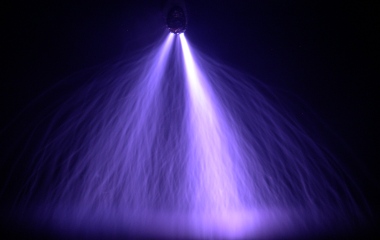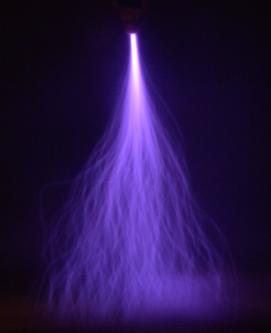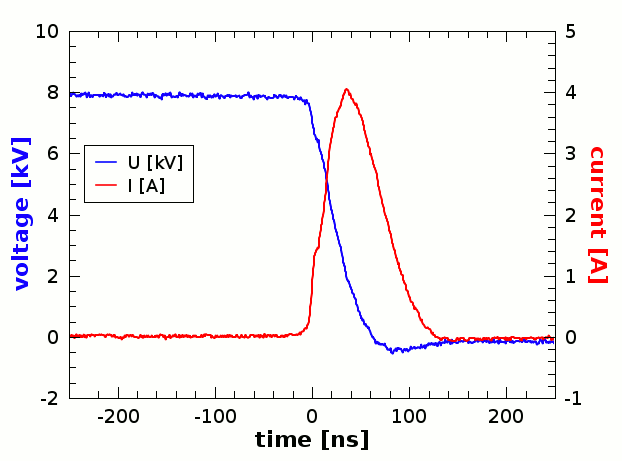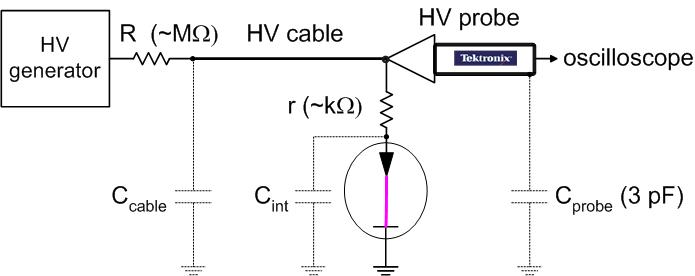Research

Research topics

1.1. Introduction
1.2. Diagnostic methods
1.3. Numerical modeling
1.4. DC glow discharge
1.5. Transient spark
1.6. Microwave plasma
1.7. Discharges in porous materials and capillaries
1.8. Discharges with water
2. Bio-medical plasma applications
3. Environmental plasma applications
4. Non-plasmatic environmental technologies
1.5. Transient spark
Repetitively pulsed discharge in air is a power reduction strategy based on pulsed electron heating. Pulsed power is a very effective way of producing non-thermal plasmas at low energy costs. However, costly pulsed power generators able to produce ns-rise time pulses of several kV with frequencies of 10-100 kHz are needed. We therefore investigated an interesting pulsed discharge generated by a cheap DC power supply. This novel streamer-to-spark transition discharge with short strong current pulses (named Spontaneously Pulsing Transition Discharge, SPTD, or Transient Spark, TS) generates very active non-equilibrium (cold) plasma.
When a DC high voltage of a few kV is applied to the point electrode of a non-uniform field gap, streamer corona appears. It is typical with small current pulses of streamers (~10 mA) with a repetitive frequency of 10-30 kHz, during which the discharge voltage remains fairly constant. As the voltage is further increased, the streamers establish a conductive channel that leads to a spark formation with excessive current pulse (Fig. 1).
In our case, the spark pulse current is limited in by 1) the ballast resistor R that drops the voltage as the current increases, and 2) the capacity C between the electrodes that is small (order of 10 pF). Thus, even if the sparks forms, it is only transient since the discharged energy is small (~0.1-1 mJ), that is why we call this discharge transient spark. After the pulse, C is recharged by a growing potential on the stressed electrode. As soon as C is charged enough again, it triggers a new pulse. This transient spark becomes then a repetitive streamer-to-spark transition discharge, with each spark pulse (~1 A) preceded by one or a sequence of streamer pulses. The repetitive frequency of pulses is 0.5-5 kHz, and increases with the growing applied voltage. Thanks to the very short spark pulse duration (~100 ns) given by the small C and a limiting R, the plasma remains cold.
By setting the values of R and C (C can be set by the length of the HV cable or by filtering Ccable + Cprobe by a small resistor put very near the high voltage electrode, Fig. 2) we can either obtain the transient spark pulses and regulate their amplitude, or obtain a continuous discharge. This pulse-less DC glow discharge typically appears after the spark pulse if R ≤ 1 MΩ and so the voltage drops to a certain small value but not zero, high enough though to sustain a small current (~mA).
The TS has already been successfully tested for several environmental and bio-medical applications (see sections 2. Bio-medical plasma applications and 3. Environmental plasma applications ), and extensive fundamental research of TS using several electrical and optical diagnostic methods has been performed (see subsection 1.2. Diagnostic methods).
More details in:
| Machala Z.: Continuous and transient electrical discharges, streamer triggered, at atmospheric pressure, for the removal of Volatile Organic Compounds (VOC), Ph.D. thesis, University Paris-Sud XI, France, Comenius University Bratislava, Slovakia, (2000). abstract | download | citations: 7 |
| Machala Z., Janda M., Hensel K., Jedlovský I., Leštinská L., Foltin V., Martišovitš V., Morvová M.: Emission spectroscopy of atmospheric pressure plasmas for bio-medical and environmental applications, J. Molec. Spectrosc. 243 (2), 194-201 (2007). abstract | download | citations: 311 |
| Machala Z., Jedlovský I., Martišovitš V.: DC discharges in atmospheric air and their transitions, IEEE Trans. Plasma Sci. 36, 918-919 (2008). abstract | download | citations: 44 |
| Janda M., Machala Z.: Transient spark discharge in N2/CO2/H2O mixtures at atmospheric pressure, IEEE Trans. Plasma Sci. 36 (4), 916-917 (2008). abstract | download | citations: 6 |
| Janda M., Martišovitš V., Machala Z.: Transient spark: a dc-driven repetitively pulsed discharge and its control by electric circuit parameters, Plasma Sources Sci. Technol. 20, 035015 (10pp) (2011). abstract | download | citations: 60 |
| Janda M., Machala Z., Niklová A., Martišovitš V.: The streamer-to-spark transition in a transient spark: a dc-driven nanosecond-pulsed discharge in atmospheric air, Plasma Sources Sci. Technol. 21, 045006 (9pp) (2012). abstract | download | citations: 68 |
| Janda M., Martišovitš V., Dvonč L., Hensel K., Machala Z.: Measurement of the electron density in transient spark discharge, Plasma Sources Sci. Technol. 23 (6), 065016, 12 pp (2014). abstract | download | citations: 43 |


